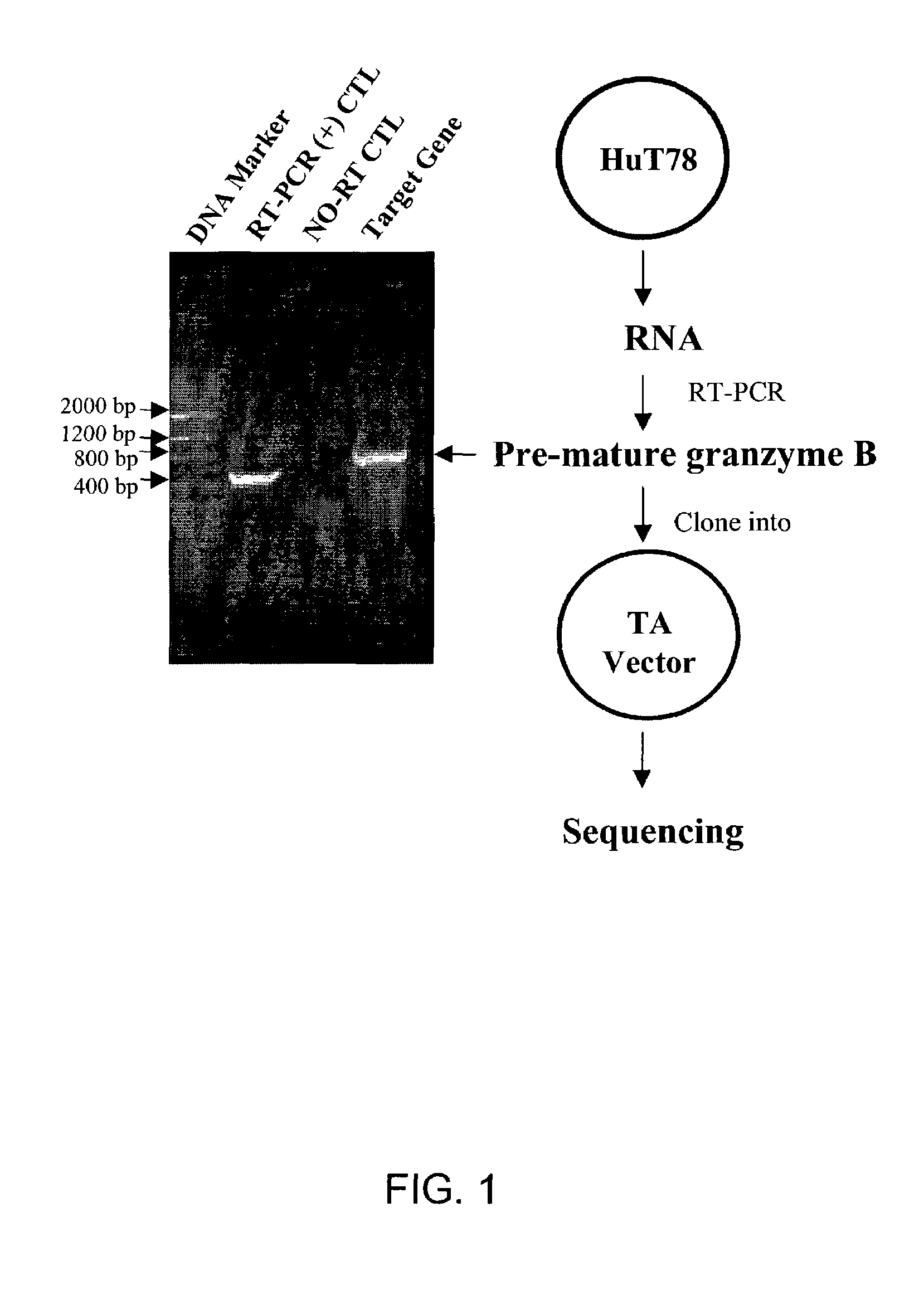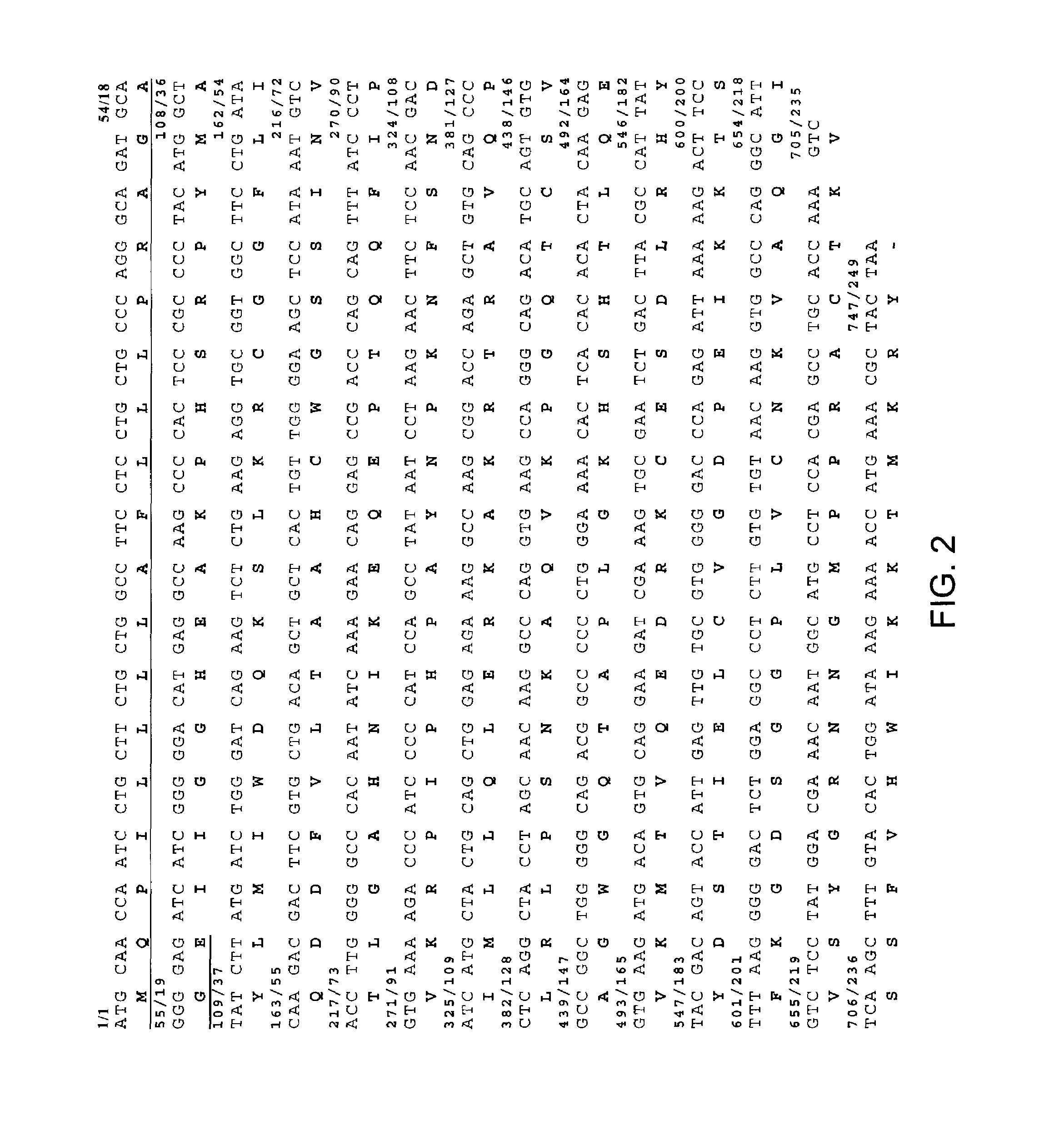Therapeutic agents comprising pro-apoptotic proteins
a technology of proapoptosis and therapeutic agents, applied in the field of cancer biology, can solve the problems of high toxicity to target cells
- Summary
- Abstract
- Description
- Claims
- Application Information
AI Technical Summary
Benefits of technology
Problems solved by technology
Method used
Image
Examples
example 1
Materials
[0348]The following materials were utilized for multiple Examples described herein. The PCR reagents were obtained from Fisher Scientific (Pittsburgh, Pa.), and the molecular biology enzymes were purchased from Boehringer Mannheim (Indianapolis, Ind.) or New England Biolabs (Beverly, Mass.). Bacterial strains, pET bacterial expression plasmids and recombinant enterokinase were obtained from Novagen (Madison, Wis.). All other chemicals were from Sigma Chemical Company (St. Louis, Mo.) or Fisher Scientific (Pittsburg, Pa.). Metal affinity resin (Talon or Nichel agrose) was obtained from Clontech Laboratories (Palo Alto, Calif.). Tissue culture reagents were from Gibco BRL (Gaithersburg, Md.).
[0349]Human cutaneous T cell lymphoma (Hut78) from American Type Culture Collection (ATCC, Manassas, Va.) cultured in RPMI 1640 medium containing 10% fetal bovine serum (FBS). Porcine aortic endothelial cells transfected with either flt-1 receptor (PAE-Flt-1) or the flk-1 / KDR receptor (PA...
example 2
Methods—Cloning Human Granzyme B Gene
[0350]The following methods were utilized at least for Example 13. Hut78 RNA was isolated using GlassMAX RNA Microisolation Spin Cartridge System (Gibco BRL), and the quanitity of total RNA was then determined. Genomic DNA was then removed by incubating the sample with DNase I for 15 min at room temperature. The DNase I was inactivated by adding EDTA solution heating for 15 min at 65° C. The SUPERSCRIPT First-Strand Synthesis System for RT-PCR (Gibco BRL) was used to synthesize the first-strand with oligo (dT). The target cDNA (pre-mature human Granzyme B cDNA) was amplified using the primers: NcoIgb (5′ to 3′): GGTGGCGGTGGCTCCATGGAACCAATCCTGCTTCTG (SEQ ID NO:1) and CxhoIgb (5′ to 3′): GCCACCGCCTCCCTCGAGCTATTAGTAGCGTTTCATGGT (SEQ ID NO:2) by PCR. PCR conditions included denaturation at 95° C. for 5 min, PCR cycle of 94° C. for 1 min, 50° C. for 1 min, 72° C. for 1 min, for a total of 30 cycles; extension step was 72° C. for 5 min. A 1% agarose ge...
example 3
Methods—Construction of Granzyme B-VEGF121 or Granzyme B-SCFVMEL Fusion Genes
[0351]The following fusion constructs were utilized in multiple Examples described herein. The fusion construct Granzyme B-vegf121 was an Ek-Granzyme B-G4S linker-Vegf121 format. The construction was based on over-lap PCR method. Briefly, granzyme B coding sequence was amplified from gbTA-2 by PCR using the primers: NgbEK (5′ to 3′): GGTACCGACGACGACGACAAGATCATCGGGGGACATGAG, Cgb (5′ to 3′) (SEQ ID NO:3) and GGAGCCACCGCCACCGTAGCGTTTCATGGT (SEQ ID NO:4). These were designed to delete the signal sequence of pre-mature granzyme B and insert an enterokinase cleavage site at the N-terminus, in addition to adding a G4S linker sequence to the C-terminus in order to link to vegf121 gene. Vegf121 sequence was amplified from a plasmid pET22-vegf121 (a gift from Dr. Phil Thorpe's group, the University of Texas Southwest Medical School, Dallas, Tex.) by PCR using primers: Nvegf (5′ to 3′) GGTGGCGGTGGCTCCGCACCCATGGCAGAA (...
PUM
| Property | Measurement | Unit |
|---|---|---|
| temperature | aaaaa | aaaaa |
| ionic strength | aaaaa | aaaaa |
| pH | aaaaa | aaaaa |
Abstract
Description
Claims
Application Information
 Login to View More
Login to View More - R&D
- Intellectual Property
- Life Sciences
- Materials
- Tech Scout
- Unparalleled Data Quality
- Higher Quality Content
- 60% Fewer Hallucinations
Browse by: Latest US Patents, China's latest patents, Technical Efficacy Thesaurus, Application Domain, Technology Topic, Popular Technical Reports.
© 2025 PatSnap. All rights reserved.Legal|Privacy policy|Modern Slavery Act Transparency Statement|Sitemap|About US| Contact US: help@patsnap.com



